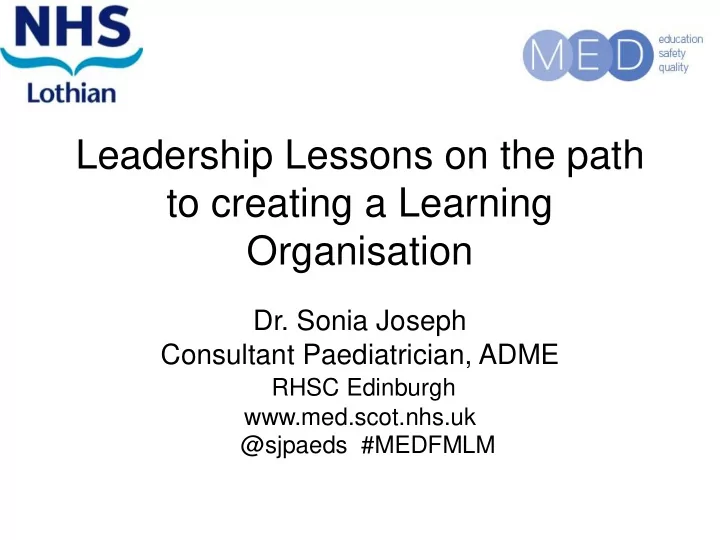

Leadership Lessons on the path to creating a Learning Organisation Dr. Sonia Joseph Consultant Paediatrician, ADME RHSC Edinburgh www.med.scot.nhs.uk @sjpaeds #MEDFMLM
NHS Lothian Population 2018 • SES 2804,400 people NHS Lothian • 708,100 people • 405,000 Emergency admissions Aug,Dec, Infrastructure Feb, April > 400 • 5 teaching hospitals & 32 peripheral sites, 124 GP practices Workforce • 800 Medical students • 1300 Junior doctors https://www.isdscotland.org/Health-Topics/Hospital-Care/Publications/2018-09-25/2018-09-25- Annual-QuarterlyAcuteActivity-Report.pdf?96015566588
85% https://www.ted.com/talksmargaret_heffernan_the_dangers_of_willful_blindness https://corporate-rebels.com/iceberg-of-ignorance/
Bronfenbrenner’s Ecological Systems Theory Professional Bodies System Culture What they Developed Personal think they Beliefs Skills gain from training What they Childhood & Doctor actually health factors gain from Learning training! Styles Jones, D; Aitken, G; Fawns, T; Joseph, S (2019) Systems Thinking in Medical Education: Seeing the Individual in the Bigger Picture. Scottish Medical Education Conference Workshop, Session 3: 24
The facts • 10% Patient admissions experience harm as a result of medical error (WHO 2008) • 6 %-13% Increase in mortality reported in hospitals on first Wednesday in August • 49% of 139 reflective notes on e-portfolio of 30 FY1 doctors had documented patient safety incidents in them (Ahmed et al 2012) • UKFPO 58% of medical students took a medical post in the same region as their medical school • 38% of University of Edinburgh students stay on for Foundation Year 1 in Lothian • FY > Specialty Training • 2011 -71.3% • 2017- 42.6% • GMC July 2017 > 90% of previous FY2 were back in training 4 years after FY2
2012 Challenges Changing Known Unknowns national perspectives Overcoming improvement Organisational silos inertia and Culture Nomadic Staffing group Significant variation in knowledge, skills and needs of individuals No curriculum, aims and objectives for induction No ability to learn from patient stories and SAE
Where we were Dental trainee/ Consultant locums/honorary Medical Non-training grades Student HR/O H/IT Trainee Doctor Patient
Patient Safety Latent Failure Conditions of Active • Management Work Failures Barrier Decisions Accident/ • Organisational • Workload • Unsafe acts Processes Harm • Culture • Omissions • Supervision • Action • Communication slips/failure s • Equipment • Cognitive • Knowledge failures • Ability • Mistakes Barrier • Violations Stages in the development of an organisational accident and an adapted model from Vincent et al114 supporting the London Protocol
2 types of changes in systems: 1 st order-change to return the system to a normal level of performance 2 nd order- a change that alters the system and results in a new level of system performance We needed 2 nd order change. Pixabay: black cave
Systems and Problems
Learning Organisations • Information is shared and accessible • Learning is emphasised and valued Doctors Learnpro • People are expected to learn constantly • Mistakes or failures are not http://doctors.learnprouk.com/doctorslanding/ punished but are used to learning Source: Peter Senge The Fifth Discipline
Where we are now MED Corporate/ network LD/HR/IT systems Dental trainee/ locums/honorary GP OOH Patient Non-training grades Consultant 3 full days at 3 full days at induction induction 4 hours/year 4 hours/year for appraisal for appraisal Trainee Doctor Medical Student SCIP Saved 10 hours per trainee per rotation = 7,740 Hrs. for FY and 28,000 hours for GP and ST
Take Home Messages • Criteria for change in complex systems • Myron’s Maxims @Myron Rogers • People own what they help create • • Real change takes place in real work • The people who do the work do the change • Connect the system to more of itself • Start anywhere, follow everywhere • The process we use to get to the future is the future we get. • The way we work together today creates the way we’ll work together tomorrow • (attributed to Kurt Lewin and Margaret Mead et al.)
Resources: www.med.scot.nhs.uk Contact: sonia.joseph@nhs.net Twitter: @sjpaeds #MEDFMLM References: https://en.wikipedia.org/wiki/NHS_Scotland https://www.ted.com/talks/margaret_heffernan_the_dangers_of_willful_ blindnes s Bronfenbrenner’s Ecological Systems Theory https://www.youtube.com/watch?v=HV4E05BnoI8 http://www.maestro-business.co.uk/cultural-operating-system/ https://blog.holacracy.org/whats-wrong-with-your-organizational-structure- 91dd71a76eb7 BMJ 2017; 356 doi: https://doi.org/10.1136/bmj.j41 (Published 13 January 2017) Cite this as: BMJ 2017;356:j41 https://www.foundationprogramme.nhs.uk/sites/default/files/2018- 07/2017%20F2%20Career%20Destinations%20Report_0.pdf 1 https://reports.gmc-uk.org/views/2017-Recruitment-PG- publicrelease/PUBDash_Summary?%3Atabs=no&%3Atoolbar=no&%3Aembed=y #3
Recommend
More recommend